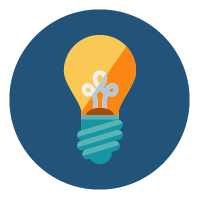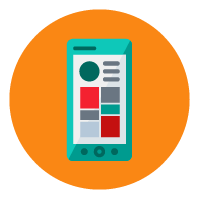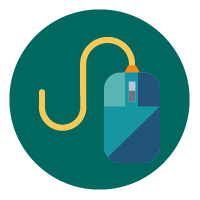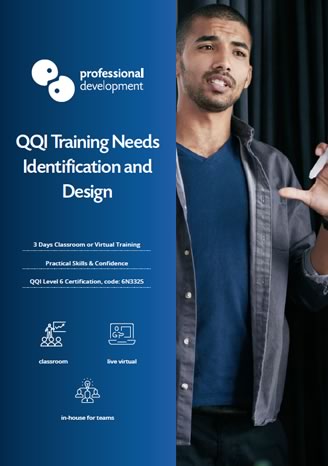Why is Training Design Important?
Originally published, September 2018. Updated January 2022.In recent years, we have noticed that training design is an area of growing interest for professional trainers, HRM personnel, and anyone who trains others as part of their role.
The ability to design great training is crucial to the success of any programme.
It is the foundation of effective training delivery and vital to the long-term impact of the programme on each participant.
In this article, we examine why this skill-set is so important for anyone involved in training. We also offer guidance on how to develop versatile skills and confidence in this area.
Download a PDF Instantly
Get immediate access to more information about this skill area in our PDF brochure for Training Needs Identification & Design.
You will gain a detailed outline of this QQI course content and certification path.
Get a BrochureJump to any part of the article:
What is Training Design?
A literal definition for “training design” would note that it means designing training sessions or programmes for a specific purpose.
However, there is a lot encompassed within the term “training design”. In order to successfully design the right kind of content, you need to:
- Identify training needs
- Understand how to translate those needs into training objectives
- Be familiar with different learning styles and theories
- Have confidence with various factors required for best-practice design
- Know how to develop appropriate content, exercises, and materials to enhance your training delivery

A Quick Note about Training Needs Analysis (TNA)
Training design relies on training needs identification.
You’ll notice that the QQI award we talk about in the “learn to design training” section is focused on both design and training needs identification.
Training needs identification is usually carried out with a TNA (training need analysis), whereby the trainer assesses what is needed and establishes clear training objectives.
You can learn more about TNA skills in our article, “Training Needs Analysis Benefits”.
Why is Training Design Important?
Without meaningful and logically constructed training modules, even the most skilled, experienced trainer will struggle.
Knowing how to create the right kind of programme enables you to keep participants engaged every step of the way.
Training put together with the structure of using effective tools and frameworks will support you in achieving your objectives.
Essentially, good training design is the backbone upon which your successful training course is built.
Training Design in HRM
Human Resource Management (HRM) personnel are frequent participants on our training design courses.

Why?
Most human resource roles incorporate the responsibility for supporting and guiding others in their professional development.
Many HR professionals are also responsible for determining and outlining the training plan for whole teams or the entire company.
Through understanding training needs identification and design, they will gain both the confidence and capability to perform both of these functions with skill.
Steps of the Training Design Process
Design is one of 4 interlinked stages within the Training Cycle. This cycle looks at the journey involved in creating and delivering training that has a lasting impact on the trainees.
Stages within the Training Cycle
- 1. Training Needs Identification
- 2. Training Design
- 3. Training Delivery
- 4. Training Evaluation
The first two steps of this cycle are very closely linked. Without accurate identification of training needs, it’s almost impossible to develop a training programme of true benefit to trainees.

The Design Process
The design process itself incorporates many different components. These include:
- Training needs analysis (TNA)
- Creating objectives
- Identifying appropriate training design models (see below)
- Selecting the right learning theory
- Mapping out and developing content
- Creating supporting exercises and handouts
Only by understanding each of these steps and how to apply the elements involved, can you confidently design a training module or programme that answers your trainees’ needs.
What is a training design model?
Training design models – also known as Instructional Design Models (IDMs) – are frameworks that inform training design.
These models offer guidelines and prompt activities that support development of the best possible content for your training project.
Here are 4 of the most popular training design models:
- The ADDIE Model
- Gagné’s 9 Levels of Instruction
- Merrill’s First Principles of Instruction
- Bloom’s Taxonomy

Getting to Grips with ISD Models
You can read short introductions to each of these models and the many others available in excellent articles throughout the internet.
However, training and guidance is essential in order to understand how to use them correctly for your training content...
Learn to design training
If you want to get confident in understanding and applying these skills, QQI Training Needs Identification & Design is a superb option.
We run this course several times a year, and it’s always fully booked. Let’s take a look at why it enjoys such a high level of popularity:
Training Needs Identification and Design
QQI Level 6 - €449 (including certification)
- Training Needs Identification and Design is a QQI Level 6 Award (award code: 6N3325).
- The 3-day course covers the syllabus required to achieve a strong understanding of the initial stages of the Training Cycle - identifying training needs and designing high-impact training sessions.
- It's part of our suite of Train the Trainer courses, focused on equipping you with the essential skills and confidence you need to become a truly effective trainer.
Get a Full Outline
Download our PDF brochure for a complete course outline. Use the "Get Dates" button below to visit the course webpage. Here, you will find detailed information and upcoming dates.
7 Benefits of Attending a Training Design Course
Become a Training Needs Analysis Ninja
Effective training begins with a great Training Needs Analysis (TNA). During this course, you’ll learn how to carry out a TNA that captures the most important information needed for training design.
Understand How People Learn
We cover the principles of adult learning during our 3-day Training Needs Identification & Design course. Understanding different learning styles is another building block for successful training.
Design Training that Packs a Punch
This course teaches you how to take the findings from a TNA and use them to craft engaging training programmes.
Accessorise Your Training Sessions
You will also acquire the tools for creating relevant support materials, such as handouts and quizzes.
Boost Your Training Delivery Skills
Gaining a comprehensive understanding of TNA and design skills provides you with a fully-rounded knowledge of what “successful training” means. As a result, your training delivery will be both sharp and focused.
Fill Your Training Toolkit
We incorporate focus on Instructional System Design (ISD) models as part of the course syllabus. These models are reliable tools in your training assessment and design work.
Get the Credibility Kudos
Achieving the QQI Level 6 Training Needs Identification and Design certification gives weight and credibility to your skills and experience.
Who attends Training Design Courses?

Professional Trainers
If you really want to shine as a professional trainer, you can’t afford to skip these steps of the Training Cycle.
Solely relying on material designed by others limits your opportunities. It restricts how much of your own stamp you can put on the training courses you run.
By completing Training Needs Identification and Design, you’ll achieve excellence in these crucial training cycle stages.

HRM Personnel
As mentioned above, HR professionals gain a lot from learning about training design. Training needs analysis in particular is extremely helpful in their work.
Through completing this course, HR personnel will have a more robust understanding of how to plan in-house training initiatives and guide individuals in their professional development.

Managers, Supervisors, and Leadership Team
Learning how to identify a need for training and define exactly where the gap in skills lies will help you guide your team in their continuous development.
You’ll also learn better ways to create mini-training sessions for processes and skills you need to teach others in your team.
How you can get started now
You can achieve a QQI Training Needs Identification and Design certification in 3 easy steps:
Step 1: Attend Training
Our 3-day course runs several times a year, with limited places available on each date.
You can click below to provisionally reserve your place on an upcoming course date:
September 9, 10, 11 Online Classroom Reserve See more dates... Step 2: Complete Self-Directed Learning and Assessment Work
You will have 8 weeks after the last date of training to complete the required work for your Training Needs Identification and Design assessment.
We will provide you with a detailed assessment brief and guidance on achieving your best from the assessment process.
Step 3: Achieve Certification
Once you have submitted all assessment work and received a passing grade, you will achieve your certification!
As with all QQI certifications, it will take a few months to receive your physical certification.
Further reading and resources
If you would like more advice and further research on whether training design is the right area for your development, here are some useful resources:
Talk to Us
Our training consultants can offer informed guidance on whether this is the right option for your development.
You can reach us directly by phone (Freephone 1800 910 810 or Dublin 01 861 0700) or ask a question online.
Call Us Ask a Question

Get our Complete Guide
Download our complete PDF Guide to Train the Trainer.
This guide includes important information for anyone involved in or considering a move into training and development.
Get the Guide

Further Reading
You can browse all of the articles on training and development in our Train the Trainer blog.
Here are 3 best articles to follow on from training design:




